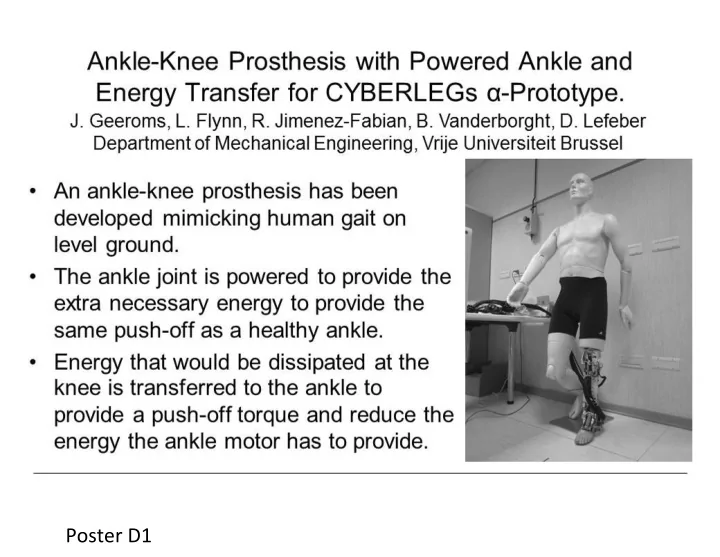

Poster D1
Strategies to reduce the configuration time for a powered knee and ankle prosthesis across multiple ambulation modes AM Simon 1,2 , NP Fey 1,2 , SB Finucane 1 , RD Lipschutz 1,2 , LJ Hargrove 1,2 1 Rehabilitation Institute of Chicago, USA 2 Northwestern University, USA • Configuring a powered knee and ankle prosthesis is challenging. • Control strategies that either mimic the behavior of biological joints or depend on instantaneous loads within the prosthesis were developed. • Three transfemoral amputees used the powered prosthesis to walk, ascend/descend a ramp, and ascend/descend stairs using a reciprocal gait. • These strategies reduced the amount of individually tuned parameters while maintaining similar kinematics to non-amputees across five ambulation modes. Poster D2
Poster D3
Clutchable Series-Elastic Actuator: Design of a Robotic Knee Prosthesis for Minimum Energy Consumption E J Rouse, L M Mooney, E C Martinez-Villalpando, H M Herr Massachusetts Institute of Technology • A novel modification to the SEA architecture was proposed by adding a clutch in parallel with the motor within the SEA (CSEA). • Tuned series elasticity was optimized to fit the spring-like torque-angle relationship. • In simulation, a CSEA prosthetic knee required 70% less electrical energy than a traditional SEA. Poster D4
EMG Control of a Bionic Knee Prosthesis: Exploiting Muscle Co-Contractions for Improved Locomotor Function J A Dawley, G D Fulk, K B Fite: Clarkson University, USA • An architecture for EMG control of knee impedance in a powered transfemoral prosthesis has been developed • Approach provides performance robustness to variation in EMG co-contraction and electrode placement • Experimental results for level walking demonstrate consistent and repeatable limb control under full weight-bearing load Poster D5
Modeling of WalkMECH: a Fully-Passive Energy-Efficient Transfemoral Prosthesis Prototype Ramazan Unal 1,2 , Feite Klijnstra 1 , Bram Burkink 1 , Sebastiaan Behrens 2 , Stefano Stramigioli 1 , Bart Koopman 2 and Raffaella Carloni 1 Robotics and Mechatronics Engineering Laboratory 1 Biomechanical Engineering Laboratory 2 University of Twente, the Netherlands • Energy-efficient fully passive transfemoral prosthesis, WalkMECH is modeled. • Dynamic model is employed for evaluating the biomechanical performance of WalkMECH. • Simulation of the model is validated with measurement data from fuctional tests. Poster D6
Novel Knee Joint Mechanism of Transfemoral Prosthesis for Stair Ascent K Inoue: Kagawa University, Japan T Wada: Ritsumeikan University, Japan R Harada, S Tachiwana: Kagawa University, Japan • A novel knee joint mechanism was proposed for stair ascent with transfemoral prosthesis without actuators • Knee flexion-lock and extension functions were designed for stance phase • Knee extension movement that realized stair ascent was accomplished with positive joint moment power generation transforming potential energy Poster D7
Poster D8
Poster D9
Poster D10
Sleeve Muscle Actuator and Its Application in Transtibial Prostheses Hao Zheng and Xiangrong Shen Department of Mechanical Engineering The University of Alabama • This paper describes the concept of a new sleeve muscle actuator, and a transtibial prosthesis design powered by this novel actuator. • Sleeve muscle is an advanced form of the traditional pneumatic muscle, with improved actuation performance and the potential for the integration of the actuator with the load-bearing structure. • The sleeve muscle-actuated transtibial prosthesis is able to generate the desired torque output within a compact form factor. Poster D11
Poster D12
Proportional EMG Control of Ankle Plantar Flexion in a Powered Transtibial Prosthesis J Wang, OA Kannape, HM Herr MIT Media Lab, Massachusetts Institute of Technology • We developed a volitional electromyographic controller to directly modulate plantar flexion 100 Intrinsic in a powered ankle-foot prosthesis — denoted Extrinsic 80 extrinsic controller. max. 60 Torque [Nm] • dorsiflexion Preliminary data suggest a transtibial 40 amputee is able to modulate key gait parameters across a wide range of walking 20 heel strike speeds using the extrinsic EMG controller. 0 toe-off foot flat • −20 Toe-off angle, net ankle work and peak −20 −15 −10 −5 0 5 power are equivalent to a biomimetic intrinsic Ankle Angle [º] (no EMG) controller on the same prosthesis. Poster D13
Poster D14
Poster D15
Pattern Recognition of Hand Movements with Low Density sEMG for Prosthesis Control Purposes J.J. Villarejo, J.F. Sarmiento, A. Frizera, T.F. Bastos: PPGEE, RENORBIO, Universidade Federal do Espírito Santo (UFES), Vitoria (Brazil) • A classification system based on sEMG has been evaluated to control a multifunctional hand prosthesis • Different kinds of hand and wrist gestures were studied, considering low-density and low-level sEMG contractions • The results showed up to 95.4% of recognition success for different groups of proposed gestures Poster D16
Recognition of Hand Movements in a Trans – Radial Amputated Subject by sEMG Manfredo Atzori (HES-SO Valais) Henning Müller (HES-SO Valais) • The Ninapro acquisition protocol for sEMG control of hand prosthetics was tested on an amputated subject. • Preliminary results show 61.51% of classification accuracy over 53 movements and the possibility to classify 13 movements without any misclassification. • Results confirmation would be important for the progress of prosthetics natural control. Poster D17
Poster D18
Task Discrimination from Myoelectric Activity: A Learning Scheme for EMG-Based Interfaces. Minas V. Liarokapis 1 , Panagiotis K. Artemiadis 2 and Kostas J. Kyriakopoulos 1 1 Sch. of Mechanical Eng., National Technical Univ. of Athens, Greece 2 Sch. for Eng. of Matter, Transport and Energy, Arizona State Univ., USA • A learning scheme based on Random Forests is used, to discriminate the task to be executed using only myoelectric activity from the upper limb. • Three different task features can be discriminated: subspace to move towards, object to be grasped and task to be executed (with the object). • Random Forests perform efficient features selection, helping us to reduce the number of EMG channels required for task discrimination. • The proposed scheme can be used by a series of EMG-based interfaces . Poster D19
Poster D20
Poster D21
Poster D22
Poster D23
Poster D24
Poster D25
Poster D26
Poster D27
Poster D28
Poster D29
Recommend
More recommend